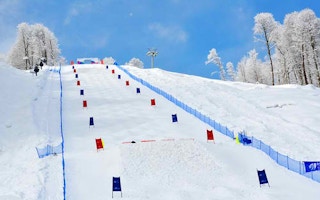The future looks cloudy for the Winter Olympics. If the world keeps on burning fossil fuels in the usual way, then of the 19 cities that have staged the event since 1924, only six are likely have enough natural snow and ice by the 2080s.
Daniel Scott, a geographer at the University of Waterloo in Canada and colleagues from Ontario and Innsbruck, Austria report in the journal Current Issues in Tourism that, on average, daytime temperatures in February at the Games sites between 1924 and 1950 were 0°4C. During the 21st century, this had changed dramatically. The average daytime maximum temperatures had reached 7.8°C.
“There are limits to what current weather risk management strategies can cope with. These limits will be increasingly tested in a warmer world,” the authors write.
The Olympic Winter Games are big business. In 1924 there were 250 amateurs from 16 countries competing in 16 medal events. In 2010 in Vancouver, Canada there were 2,500 athletes – amateur and professional – from 82 countries competing in 86 events.
“
Artificial snow technology could become more important than ever, and some places that invested heavily in Olympic facilities will become increasingly marginal, high-risk or downright unreliable
High stakes
Around 1.5 million spectator tickets were sold in Vancouver, and worldwide media broadcast revenues were more than $1.2 billion. Broadcasts reached 200 nations and a potential audience of 3.8 billion. So the Games are now a big tourist attraction, and at the same time a spectacular showcase for the host country as a future destination for pleasure-seekers.
But, say the researchers, it now looks as though artificial snow technology could become more important than ever, and some places that invested heavily in Olympic facilities will become increasingly marginal, high-risk or downright unreliable.
The authors did three things. They considered the pattern of change over the last 90 years. They analysed the minimum requirements in temperature, weather and snowfall for a games venue. And then they considered the likely warming of the next 80 years in two scenarios – one with low greenhouse gas emissions, and one under the notorious “business-as-usual” scenario.
Games planners ideally need the following: daytime maximum temperatures no higher than 10°C in February and minimums of 0°C or below (so that the slush can freeze again); as little rain as possible (because that’s really bad for snow and discouraging for spectators); natural snow deep enough for alpine and cross country skiing; and overall temperature conditions that would make artificial snowmaking possible if the natural snowfall is not enough.
Few candidates left
They distilled all these to two basic requirements: a reliable daily minimum of 0°C and 30 cms of natural snow on the hillsides. And then they checked all these against the predictions for 19 cities and resorts around the world that have already staged the games and watched the candidates eliminate themselves.
Chamonix in France, home of the first-ever games, and a famous winter playground for more than a century, becomes “high-risk/marginal” by mid-century and, under the high emissions scenario, simply “unreliable” by 2080.
The same is true for Grenoble in France, Oslo in Norway and Sarajevo in Bosnia-Herzegovina. Vancouver becomes not reliable under the high emissions scenario by 2050, and thereafter under all cases. Garmisch-Partenkirchen in Germany and Sochi in Russia, home of the 2014 games, become not reliable under all scenarios. By 2050, only 10 places will still be suitable, with reliable snow and ice. By 2080, this total will be down to six
That raises some big questions: what future is there for winter sports? Will new winter sports powers and regions emerge? Could anyone ever devise truly artificial snow – stuff that would not depend on the temperature? In a substantially warmer world, celebrating the second centennial of the Olympic Winter Games in 2124 would become “increasingly challenging,” the researchers say.

















